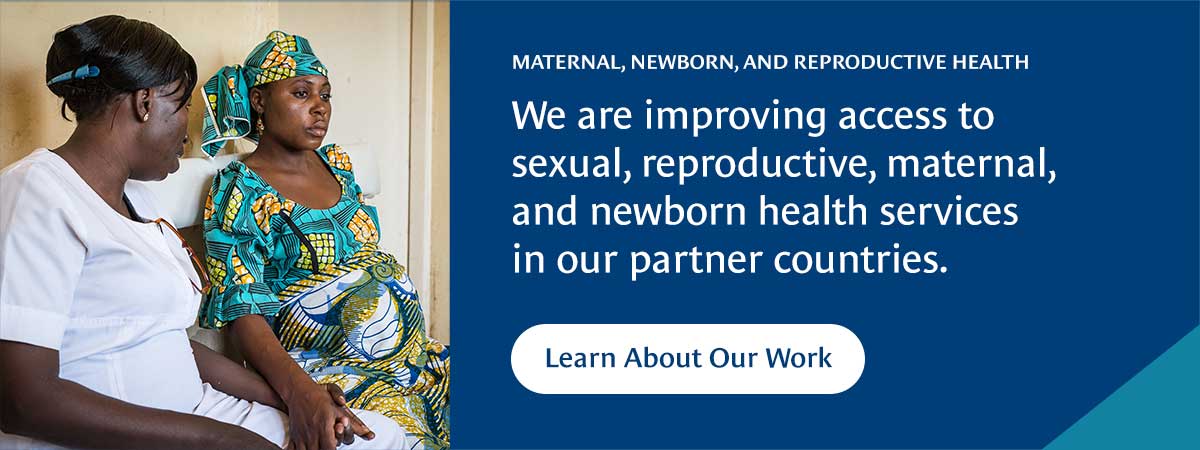Issue
Every 11 seconds, a pregnant woman, or newborn dies somewhere in the world due to birth complications. In 2021 alone, more than five million children under-five, including 2.3 million newborns died—many due to preventable or treatable causes. While globally, the under-five mortality rate fell to 38 deaths per 1,000 live births in 2021, the tragic and preventable loss of lives continued to be experienced unequally around the world, both among and within countries.
Nearly half of all under-five deaths occur during the first 28 days of life and 94 percent occur in low- and middle-income countries, reflecting inequalities towards accessing quality health services including care around the time of birth, vaccination, nutritional supplementation, and water and sanitation programs. Reducing maternal and newborn mortality is one of the most important goals facing the global health community. Although evidence-based clinical interventions can prevent a majority of these deaths, scalable and sustainable delivery of interventions across low-resource settings remains uneven.
In Zambia, the odds of survival for pregnant women and newborns living in poor rural communities can be even worse. Facilities are often not within reasonable walking distance and transportation is limited. Many births occur at home and those who make it to the facility to give birth often arrive to find the healthcare worker not adequately trained to provide the needed care. Across rural areas, babies are not named until they are six weeks old for fear of early death.
Intervention
Between 2018 and 2022 CHAI partnered with the Government of Zambia to implement an integrated Sexual Reproductive Maternal and Newborn Health (SRMNH) program in the Northern Province, the area of the country where the largest proportion of women give birth at home, face the greatest risk of death during labor, and are most likely to lose their infant to birth complications. The program was implemented across 141 government-owned health facilities covering all Northern Province’s 12 districts and home to over 1.4 million people.
Our goal was ambitious: reduce maternal and neonatal mortality across the entire province by 40 percent within four years.
Approach
In partnership with the Ministry of Health, we pursued a strategy that built on an approach CHAI previously developed and piloted in Ethiopia and later tested at scale in Northern Nigeria. The strategy included, (i) identifying complications early to prevent them becoming life-threatening (ii) applying simple interventions to ensure survival (iii) rapidly referring cases to the appropriate level for treatment and (iv) strengthening the capacity of health facilities and providers to provide quality maternal and newborn care. This program embodied a ‘Network of Care’ approach that prioritizes linkages across all levels of care to ensure client-centered, effective, efficient operations and collaborative learning. The program was designed to continue beyond CHAI’s support, by strengthening government systems to sustain mortality reductions and support scale up to other parts of the country.
Program Impact
41% reduction in maternal mortality and a 45% reduction in neonatal mortality achieved over four years
The program exceeded the original goals. As described in a recent article published in PLOS Global Public Health, there was a statistically significant 41 percent reduction in maternal mortality and a 45 percent reduction in neonatal mortality over the course of this program, based on data from a community-based system for capturing birth outcomes. In health facilities, there was a 12 percent reduction in maternal mortality and a 40 percent reduction in neonatal mortality. Service readiness and coverage of SRMNH services also improved dramatically. Further details on the approach are summarized in a two-page program brief.
Significant mortality reductions were achieved over a relatively short period, reinforced through an emphasis on sustainability and strengthening existing government systems. These results were attained through a consciously cost-efficient approach backed by substantially lower levels of external investment relative to prior programs, allowing many of the interventions to be successfully adopted by the government within public sector budgets. At the end of the program, CHAI worked with the Ministry of Health to develop and implement a transition plan. As a result, all districts committed to funding at least one component from the Sustainability and Transition Plan in their 2022 budgets, representing nearly a 60 percent increase in domestic budget allocation for SRMNH activities compared to the 2021 budget.
Next Steps
In partnership, with the Government, we are now working to plan scale up of the program nationally. By proving the approach in some of the challenging areas of the country, the Ministry of Health has been empowered to rethink old methods, move fast, and avert avoidable deaths.






